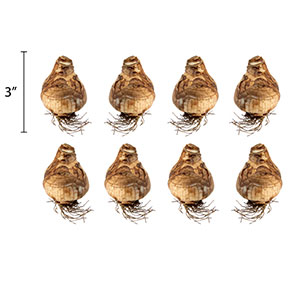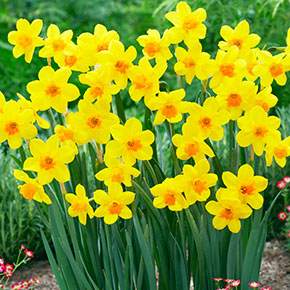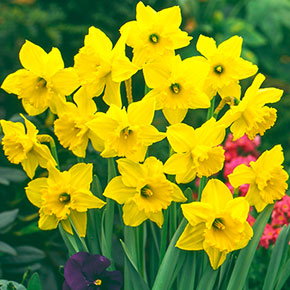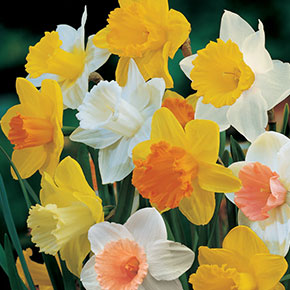-
Spring Planting
Order now for best selections.
-
Fall Planting
Available for preorder for fall 2025 delivery.
-
Bulk Flower Bulbs
Big savings on bulk orders!
- New
-
Gardening Resources
Flower Bulbs & Perennials at Wholesale Prices

How To Plant, Grow & Care For Daffodils
| Botanical Name | Narcissus |
| Plant Type | Flower bulb |
| Sun Exposure | Full sun to partial shade |
| Soil Type | Well-drained clay, loamy or sandy soils |
| Soil pH | Neutral to slightly acidic |
| Bloom Time | Early to late spring |
| Flower Color | Yellow, white, orange and pink |
| Hardiness Zones | 4, 5, 6, 7, 8, 9 |
| Special Features | It has a toxin called alkaloid lycorine that is poisonous to deer and other animals and rodents. |
During the blooming season, water daffodils regularly. After the growing season, you may want to add bonemeal to the soil to enhance the next year's blooms. Deadhead the plants as flowers die off, but do not cut the leaves for at least six weeks after they stop growing.
A Note on Pink Daffodils: When pink daffodils first unfold, the trumpet is a lovely yellow-apricot color which will gradually change to a soft pink. It is important to plant this variety in an area where they will receive full sun in order to achieve the optimal pink color. Temperatures affect daffodil colors. Warmer spring temperatures really bring out the pink or salmon-pink hues in pink daffodils, while cooler temperatures bring out their orange tones.

How to Plant Daffodil Bulbs
Keep your daffodil bulbs in good condition by planting them soon after they are delivered. If you cannot plant them right away, open the cartons. If the bulbs are in plastic bags, remove them from the plastic. Place them on a tray in a cool, dark, dry, well-ventilated area until you can plant them. Do not store them at temperatures below 39°F.Daffodil bulbs should be planted 6-8 inches deep in well-drained soil, rich in organic matter. The pointy side should be facing up. Space daffodil bulbs 3-6 inches apart. After planting, water them thoroughly. While a shovel or trowel is great for digging, an auger and drill can make daffodil bulb planting a lot easier. Both the Improved Bulb Auger and KneeSaver™ Planting Tool are time savers. Using an all-natural, slow-release fertilizer, like Van Bourgondien 100% Natural Bulb Food, at planting time can also give your daffodils a boost.
When to Plant Daffodil Bulbs
Daffodil bulbs, like other spring-blooming bulbs, should be planted in the fall, usually between September and November. A good rule of thumb is to wait until the weather cools (usually after a frost) and to plant at least 2-4 weeks before the ground freezes. To make sure that you're ready for daffodil bulb planting season and for the best selection of daffodil bulbs, we recommend ordering your daffodil bulbs from late summer to fall.Where To Plant Daffodils
Daffodils can be grown throughout much of the United States, thriving in zones 4-9. To find your hardiness zone, use our zone finder. Like other bulbs, daffodil bulbs require well-drained soil. In heavy clay and poorly drained soils, the bulbs may rot. Daffodil flowers also require full sun (6-8 hours of direct sunlight daily) to partial shade. When selecting spaces for your daffodils bulbs, keep in mind that daffodils can be planted under deciduous trees that leaf out later in the spring. Because daffodil foliage must be left up after flowering, choose areas that don't require mowing or trimming until after the foliage has matured. Some places to plant daffodil bulbs include hillsides, the edges of woods, in flower beds and underneath trees.How to Grow Daffodils
Daffodils are winter hardy in temperate regions. Adding mulch can suppress weeds and protect the bulbs in areas where winter temperatures are extremely cold.After the daffodils are done blooming in the spring, the flowers can be deadheaded for a neater appearance. Make sure to leave the foliage, as it's making food for next year's blooms.
If growing daffodil bulbs in pots, allow the foliage to fade naturally. Then dig up the daffodil bulbs and store them in a cool, dry place. Many gardeners like to replant them in the garden in the fall, and then purchase new daffodil bulbs for pots.
Daffodil bulbs can be divided every 3-5 years. Wait until after the foliage has died back before dividing them.
Daffodil Flower FAQs
Pests and Diseases
Daffodils are fairly trouble-free perennials. Deer and rabbits tend to pass them by due to a poisonous liquid called lycorine in the bulb and stem. While insect pests aren't common, they may include slugs, snails, bulb scale mite, the narcissus bulb fly and the narcissus nematode. The most common problem with daffodils is bulb rot. To help prevent this, plant daffodil bulbs in well-drained soils and avoid planting in poorly drained soils.Harvesting Tips
Daffodils make stunning cut flowers. For floral displays, cut the daffodil stem when the daffodil flower buds are full and almost ready to open.When to Transplant Daffodil Bulbs
The best time to transplant daffodil bulbs are when they are dormant. This is after the foliage has turned brown, usually in late spring to early summer. Daffodil bulbs are usually divided every 3-5 years.How to Plant Daffodils in Clumps
Daffodils look best planted in bunches or clusters. To plant daffodils in clumps, dig a hole 6-8 inches deep and evenly space the daffodil bulbs 3-6 inches apart.How to Care for Daffodils After They Bloom
Cut or deadhead daffodil flowers after they fade. Do not cut the foliage. Allow the foliage to brown and fade.When to Cut Down Daffodils
The daffodil foliage continues to absorb nutrients and create energy for next year's blooms for about six weeks after the flowers bloom. Do not cut the foliage during this time.Types of Daffodils




Have another question? Return to the Customer Service Help page or send an e-mail directly to Customer Service
Copyright © 2025 Gardens Alive!, Inc. d/b/a Dutchbulbs.com. All Rights Reserved. Dutchbulbs.com trademarks are registered trademarks of Gardens Alive!, Inc.
This site is protected by reCAPTCHA and Google Privacy Policy and Terms apply.
This site is protected by reCAPTCHA and Google Privacy Policy and Terms apply.

Item added to cart





